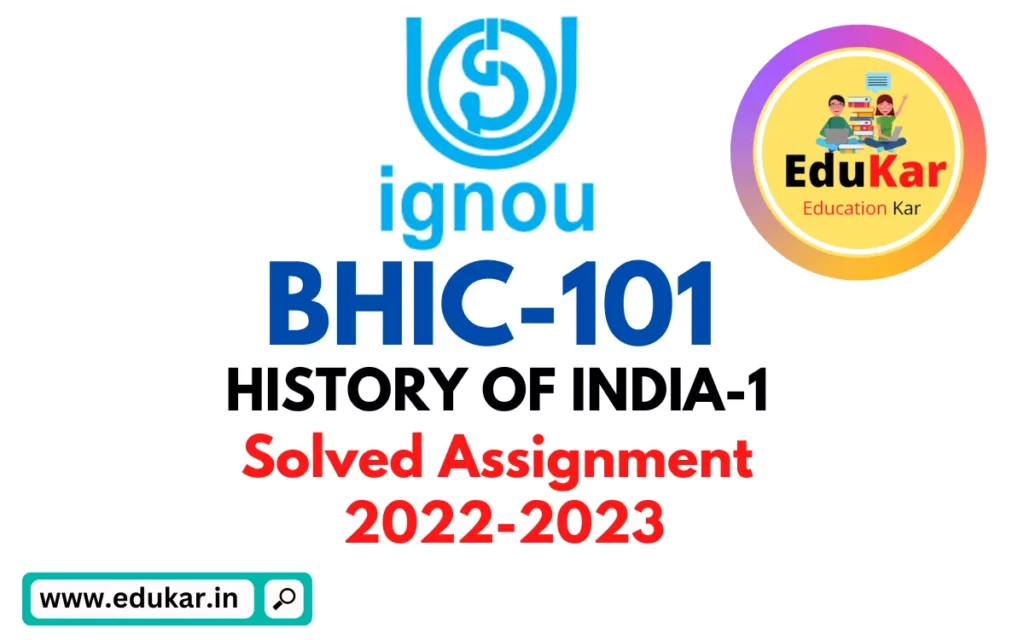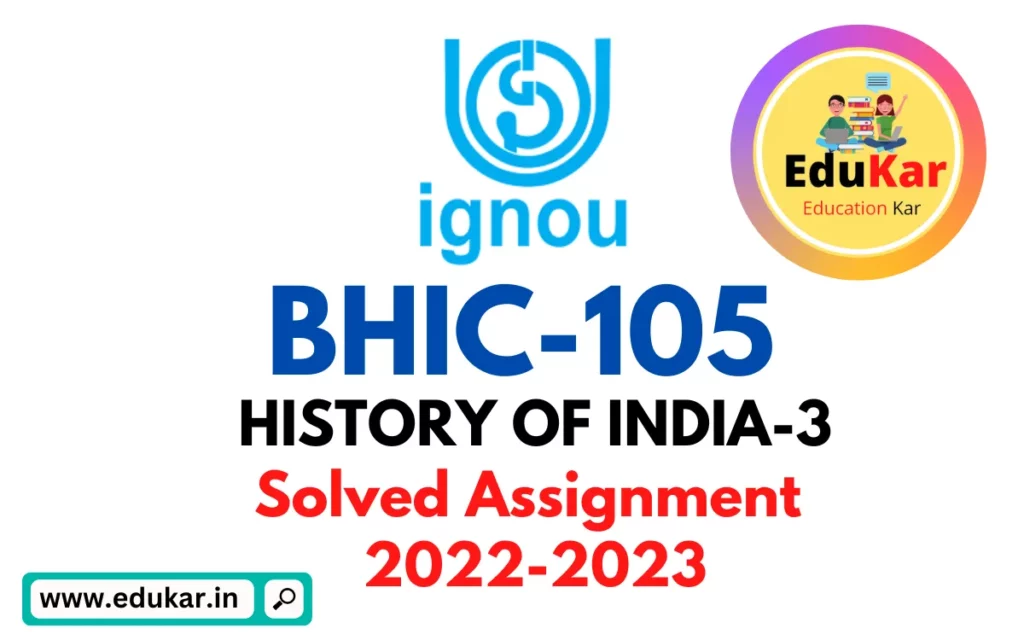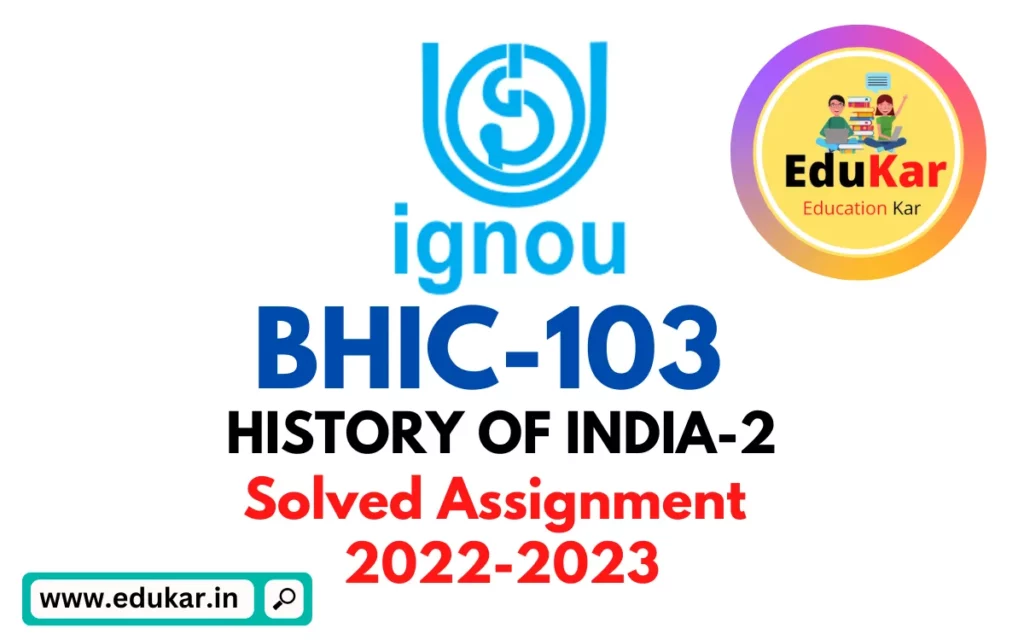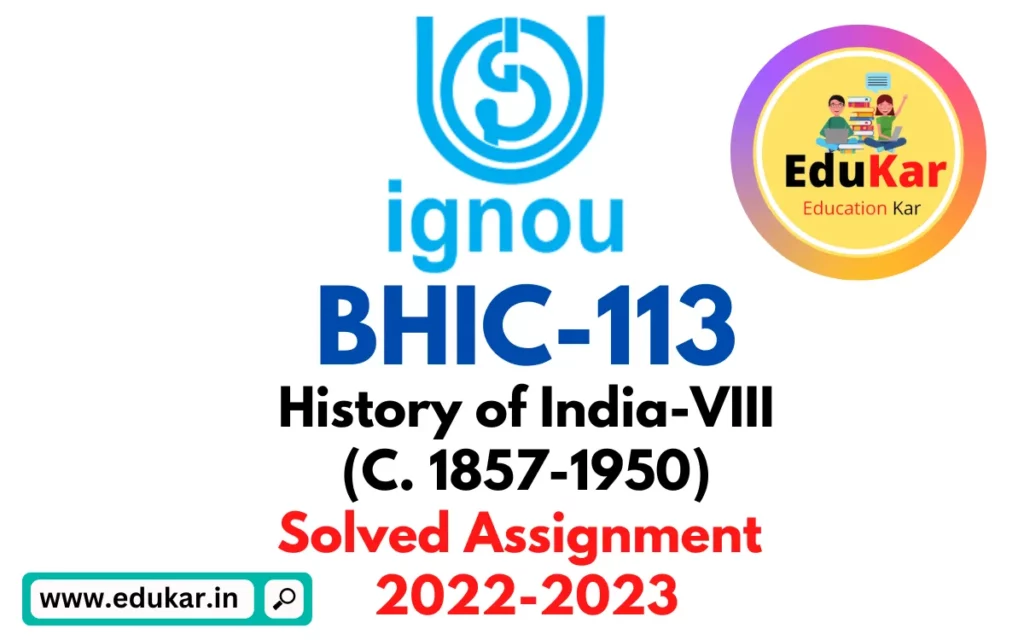Contents
- 1 Assignment – I
- 2 Answer the following in about 500 words each.( Any two)
- 3 1. What is a literary source? Evaluate the relevance of Puranas and Sangam literature in the reconstruction of ancient Indian history.
- 4 2. What do you understand by archaeological excavation? What is the difference between archaeological exploration and excavation?
- 5 3. Briefly discuss the character of Early Harappan Civilization? Describe the major sites of the early Harappan period.
- 6 Assignment – II
- 7 Answer the following questions in about 250 words each.
- 8 4) Discuss the nature of economy and religion of the early Vedic period.
- 9 5. Explain the growth of Buddhism.
- 10 6. Describe the administrative machinery of the Maurya Empire.
- 11 Assignment – III
- 12 Answer the following questions in about 100 words each.
- 13 7. Peninsular India
- 14 8. Neolithic Culture of Kashmir Valley
- 15 9. Satavahana Dynasty
- 16 10. Tamilaham
- 17 11. Poetry Organization
- 17.1 How to Download BHIC-131 Solved Assignment 2022-2023 (History of India from the earliest times up to c. 300 C.E) Solved Assignment?
- 17.2 Is the BHIC-131 Solved Assignment 2022-2023 (History of India from the earliest times up to c. 300 C.E) Solved Assignment Free?
- 17.3 What is the last submission date for (IGNOU-BAG) Solved Assignment?

| Title | IGNOU: BHIC-131 Solved Assignment 2022-2023 (History of India from the earliest times up to c. 300 C.E.) |
| University | IGNOU |
| Degree | Bachelor Degree Programme |
| Course Code | BHIC-131 |
| Course Name | History of India from the earliest times up to C. 300 C.E. |
| Programme Name | Bachelor of Arts (General) |
| Programme Code | BAG |
| Total Marks | 100 |
| Year | 2022-2023 |
| Language | English |
| Assignment Code | BHIC-131/ASST/TMA/2022-23 |
| Last Date for Submission of Assignment: | For June Examination: 31st March For December Examination: 30th September |
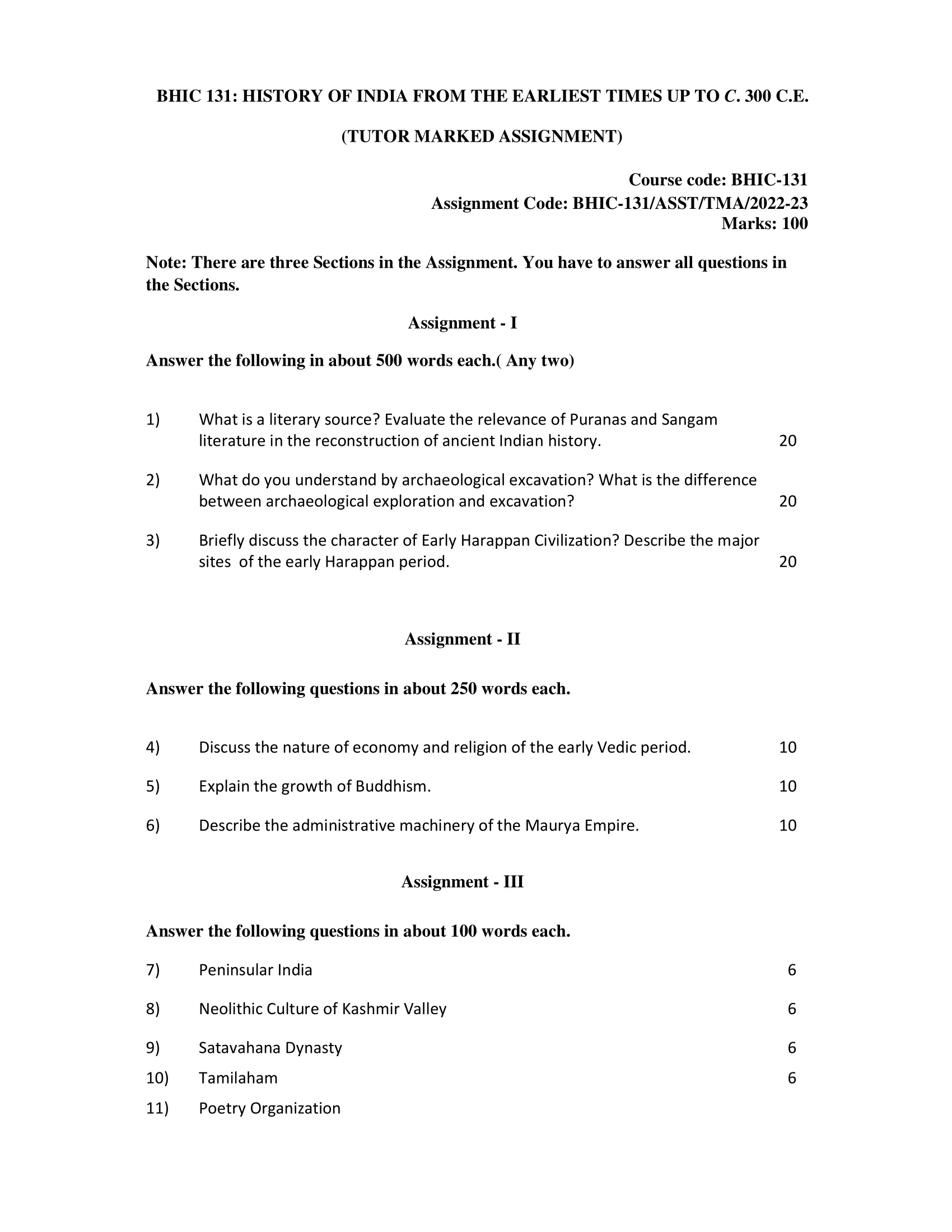
Assignment – I
Answer the following in about 500 words each.( Any two)
1. What is a literary source? Evaluate the relevance of Puranas and Sangam literature in the reconstruction of ancient Indian history.
Ans: A literary source is a piece of writing or text that serves as evidence for a historical event, culture, or tradition. It can be in the form of a poem, a novel, a play, or any other written work that has historical significance. Literary sources are important for reconstructing the past, as they often provide insights into the beliefs, values, and daily life of a particular society.
The Puranas and Sangam literature are two important literary sources for the reconstruction of ancient Indian history. The Puranas are a collection of Hindu religious texts, believed to have been written between 300 BCE and 300 CE. They contain stories and legends about the gods, goddesses, and the creation of the universe. The Puranas also provide information on the social, cultural, and political life of ancient India.
Sangam literature is a collection of Tamil poems and songs, believed to have been written between 300 BCE and 300 CE. These works provide insights into the society, culture, and politics of ancient Tamil Nadu. They describe the daily life of the people, their beliefs, and their customs. The Sangam literature also contains information on the political situation of ancient Tamil Nadu, including the various kingdoms and their rulers.
The relevance of the Puranas and Sangam literature in the reconstruction of ancient Indian history is significant. The Puranas and Sangam literature provide valuable information on the religious and cultural beliefs of ancient India, as well as its social and political structures. These works help to fill in gaps in our understanding of ancient Indian history and provide a glimpse into the daily life of the people.
However, it is important to note that literary sources are not always reliable sources of historical information. They are often biased and written with a particular agenda in mind, and may not accurately reflect the actual events that took place. Additionally, the Puranas and Sangam literature were written many years after the events they describe, and the oral transmission of information may have led to inaccuracies and alterations in the text.
2. What do you understand by archaeological excavation? What is the difference between archaeological exploration and excavation?
Ans: Archaeological excavation is the systematic and methodical removal of soil and other materials in order to uncover and study buried artifacts, structures, and other remains. It is a critical component of archaeological research and provides valuable information about the history and culture of a particular place. Excavation is carried out in stages, starting with the removal of the topsoil and progressing down to deeper layers. The excavation process involves mapping, recording, and analyzing the artifacts and structures that are uncovered.
Archaeological exploration, on the other hand, refers to the initial stage of an archaeological investigation. This stage involves identifying and surveying potential archaeological sites, and conducting preliminary research to determine the significance and feasibility of a full excavation. This can involve remote sensing, geophysical surveys, and surface surveys to locate and map potential sites.
The main difference between archaeological exploration and excavation is that exploration is the first step in the process of uncovering and studying buried artifacts and structures, while excavation is the actual removal and analysis of those remains. Exploration is typically focused on identifying and assessing potential sites, while excavation is focused on the excavation and analysis of artifacts and structures.
Another difference between the two is the level of detail and precision involved. Exploration is often conducted at a more preliminary level, while excavation is a more detailed and systematic process. Excavation requires careful planning and execution in order to preserve the context of the site and the artifacts and structures that are uncovered. It also requires the use of specialized tools and techniques to excavate and analyze the materials that are uncovered.
Excavation is a time-consuming and often expensive process, and requires a significant amount of resources, expertise, and equipment. The results of an excavation, however, can provide valuable information about the history and culture of a particular place, and contribute to our understanding of the past.
3. Briefly discuss the character of Early Harappan Civilization? Describe the major sites of the early Harappan period.
Ans: The Early Harappan Civilization, also known as the Indus Valley Civilization, was a Bronze Age civilization that existed in the region of present-day Pakistan and northwest India from about 3300 BCE to 2600 BCE. The Early Harappan period is considered the formative stage of the Indus Valley Civilization, characterized by the development of urban settlements and the beginnings of long-distance trade and communication.
The Early Harappan people were skilled in agriculture, metallurgy, and craft production, and developed a sophisticated system of weights and measures, suggesting a high level of social organization and economic complexity. The society was likely hierarchical, with a ruling class and a system of governance. Religion was also an important aspect of Early Harappan life, as evidenced by the discovery of religious symbols and figurines at various sites.
The major sites of the Early Harappan period include:
- Mehrgarh: Located in present-day Pakistan, Mehrgarh is considered one of the earliest and most important settlements of the Early Harappan period. Excavations at the site have revealed evidence of agriculture, metallurgy, and craft production, and suggest a well-organized and complex society.
- Harappa: Another important site of the Early Harappan period, Harappa is located in present-day Pakistan and is known for its well-planned urban layout and sophisticated system of drains and sewage. The site has also yielded evidence of long-distance trade, including imported items from as far away as Mesopotamia.
- Mohenjo-daro: Mohenjo-daro is another major Early Harappan site, located in present-day Pakistan. The site is notable for its well-planned urban layout, with a grid-like street pattern and a sophisticated system of drains and sewage. Excavations at the site have also revealed evidence of a complex society, including a citadel, a Great Bath, and various religious structures.
- Kalibangan: Kalibangan is an Early Harappan site located in present-day India, and is known for its well-planned urban layout and evidence of agriculture and metallurgy. The site also contains the remains of a fire altar, suggesting the importance of religious rituals in Early Harappan society.
The Early Harappan period was characterized by the development of urban settlements and the beginnings of long-distance trade and communication. The people of this period were skilled in agriculture, metallurgy, and craft production, and developed a sophisticated system of weights and measures. The major sites of the Early Harappan period include Mehrgarh, Harappa, Mohenjo-daro, and Kalibangan, and offer valuable insights into the social, economic, and religious aspects of this early civilization.
Assignment – II
Answer the following questions in about 250 words each.
4) Discuss the nature of economy and religion of the early Vedic period.
Ans: The early Vedic period, which dates back to approximately 1500-1000 BCE, was characterized by a predominantly agricultural economy. The dominant economic activity was subsistence agriculture, with cattle rearing and trade playing a smaller role. Land was considered the most valuable form of wealth, and ownership of it was an important factor in determining social status.
Religion during the early Vedic period was highly influential and dominated all aspects of society. The Vedas, the oldest Hindu scriptures, served as the basis for religious beliefs and practices. The people of this period worshiped a pantheon of gods, with Indra, Agni, and Soma being the most prominent. The central religious rite was the sacrifice, which involved offering food, drink, and sometimes animals to the gods in exchange for their blessings. The priests, who were drawn from the upper classes, performed these sacrifices and were highly regarded.
The relationship between the economy and religion during the early Vedic period was closely intertwined. The economy was largely based on agriculture, and the gods were believed to control the fertility of the land and the success of crops. Therefore, the sacrifices performed were seen as crucial for ensuring the prosperity of the community. Wealthy individuals and families would often perform elaborate sacrifices, which served as a way to demonstrate their wealth and status.
5. Explain the growth of Buddhism.
Ans: Buddhism originated in ancient India around the 5th century BCE and has since grown into a global religion with millions of followers. The religion was founded by the Buddha, also known as Siddhartha Gautama, who taught that the path to enlightenment and liberation from suffering lies in the Four Noble Truths and the Eightfold Path.
The early growth of Buddhism was slow, but it eventually gained momentum, particularly in the Mauryan Empire where Emperor Ashoka became a devout follower and helped spread Buddhism throughout his kingdom. Buddhism also spread to other countries through the Silk Road trade routes and the efforts of Buddhist missionaries.
One of the major factors that contributed to the growth of Buddhism was its appeal to the masses, especially to those who were dissatisfied with the caste system and the domination of the Brahmins. Buddhism offered a way to escape the cycle of rebirth and attain enlightenment regardless of one’s social status.
Buddhism also spread due to its universal message of peace, compassion, and non-violence, which resonated with people of different cultures and backgrounds. The religion’s emphasis on compassion and altruism has made it a beloved and respected religion in many countries.
Buddhism also experienced a revival in the 19th and 20th centuries, particularly in Asia where it had originally originated. This was due to a renewed interest in spirituality and religion and the efforts of Buddhist reform movements and modernizing monks who sought to bring Buddhism into the modern world.
6. Describe the administrative machinery of the Maurya Empire.
Ans: The Maurya Empire, which existed from approximately 321 to 185 BCE in ancient India, had a highly organized and efficient administrative machinery. The empire was ruled by the powerful emperor Ashoka, who centralized the administration and ensured the smooth functioning of the government through a number of measures.
One of the key elements of the Mauryan administration was the division of the empire into provinces, each with its own governor who was responsible for maintaining law and order and collecting taxes. The provinces were further divided into districts, each with its own administrator who was responsible for maintaining records and implementing government policies.
The Mauryan administration also had a well-developed system of taxation and revenue collection, which was crucial for financing the empire’s military and infrastructure projects. The tax system was based on a combination of land and trade taxes, and the government took measures to ensure that the collection of taxes was fair and transparent.
The Mauryan administration also had a strong military, which was necessary for maintaining order and ensuring the security of the empire. The army was divided into infantry, cavalry, and elephants and was well-equipped and well-trained.
In addition to these administrative measures, the Mauryan administration also made efforts to ensure the welfare of the people. Ashoka is known for his policies of non-violence, religious tolerance, and public welfare, which helped to maintain stability and improve the standard of living for the people.
Assignment – III
Answer the following questions in about 100 words each.
7. Peninsular India
Ans: Peninsular India refers to the triangular-shaped region located in southern India and is surrounded by the Arabian Sea on the west, the Indian Ocean on the south, and the Bay of Bengal on the east. It is separated from the rest of the Indian subcontinent by the Himalayan mountain range to the north. Peninsular India is known for its rich cultural heritage, diverse landscapes, and varied climatic conditions, ranging from tropical to semi-arid. This region has been inhabited for thousands of years and has a long and complex history, marked by the rise and fall of many kingdoms and empires. Some of the most important cultural and religious centers of India, such as Bangalore, Chennai, and Hyderabad, are located in Peninsular India.
8. Neolithic Culture of Kashmir Valley
Ans: The Neolithic culture of Kashmir Valley in northern India dates back to around 5000 BCE and is known for its rich cultural heritage and sophisticated craftsmanship. This early period of human history in the region is characterized by the development of agriculture, animal husbandry, and the use of stone tools.
The Neolithic people of Kashmir Valley were skilled farmers, and they relied heavily on agriculture for their livelihood. They also raised animals such as sheep, goats, and cattle and were skilled in weaving, pottery, and metalworking.
The Neolithic culture in Kashmir Valley is also known for its rich rock art, which includes petroglyphs and rock paintings. These artworks depict various scenes of daily life, including hunting, agriculture, and animal husbandry, and provide valuable insights into the lives of these early people.
9. Satavahana Dynasty
Ans: The Satavahana Dynasty was a royal Indian dynasty that ruled over a large portion of present-day central and southern India from the 2nd century BCE to the 3rd century CE. The Satavahanas were known for their patronage of Buddhism and for promoting trade and commerce through the establishment of a network of roads and ports. They were also responsible for the creation of several great cities, such as Amaravati, which became a center of Buddhist learning and culture. The Satavahana kings were known for their piety and for the construction of many Buddhist stupas and monasteries, which contributed to the spread of Buddhism in India. Despite facing challenges from the invasions of foreign powers and internal conflicts, the Satavahana dynasty maintained its rule for several centuries, making it one of the longest-lasting dynasties in Indian history.
10. Tamilaham
Ans: Tamilaham refers to the ancient Tamil-speaking region in southern India, which was centered around the present-day state of Tamil Nadu. The region has a rich cultural history dating back to the Sangam period (300 BCE to 300 CE), during which time the Tamil language and literature flourished.
The Tamilaham region was home to several powerful dynasties, including the Chera, Chola, and Pandya dynasties, each of which made significant contributions to the region’s cultural and economic development. The Cholas, in particular, were known for their impressive architectural achievements, including the construction of magnificent temples and grand palaces.
Tamilaham is also known for its rich artistic and literary traditions, including the classical Tamil language and its epic poems, such as the Silappadikaram and the Manimekalai. These works are considered some of the greatest literary achievements in the Tamil language and provide valuable insights into the lives and culture of the ancient Tamil-speaking people.
11. Poetry Organization
Ans: Poetry organization refers to the structure and arrangement of a poem, which can greatly affect its meaning, impact, and beauty. There are many different forms of poetry organization, including rhymed and unrhymed forms, metered and unmetered forms, and traditional and modern forms.
Some common forms of rhymed poetry include sonnets, rhyming couplets, and rhyming stanzas. Metered forms, such as iambic pentameter, use regular patterns of stressed and unstressed syllables to create a rhythm in the poem.
In contrast, unrhymed forms, such as free verse, do not follow a set rhyme or meter. These forms offer more flexibility and allow the poet to focus more on the content and meaning of the poem.
Poetry organization can also refer to the arrangement of lines and stanzas within a poem, which can impact the poem’s meaning, emotional impact, and flow. Effective poetry organization can help to emphasize the poem’s central message and create a memorable and enjoyable reading experience.
How to Download BHIC-131 Solved Assignment 2022-2023 (History of India from the earliest times up to c. 300 C.E) Solved Assignment?
You can download it from the www.edukar.in, they have a big database for all the IGNOU solved assignments.
Is the BHIC-131 Solved Assignment 2022-2023 (History of India from the earliest times up to c. 300 C.E) Solved Assignment Free?
Yes this is absolutely free to download the solved assignment from www.edukar.in
What is the last submission date for (IGNOU-BAG) Solved Assignment?
For June Examination: 31st March, For December Examination: 30th September



